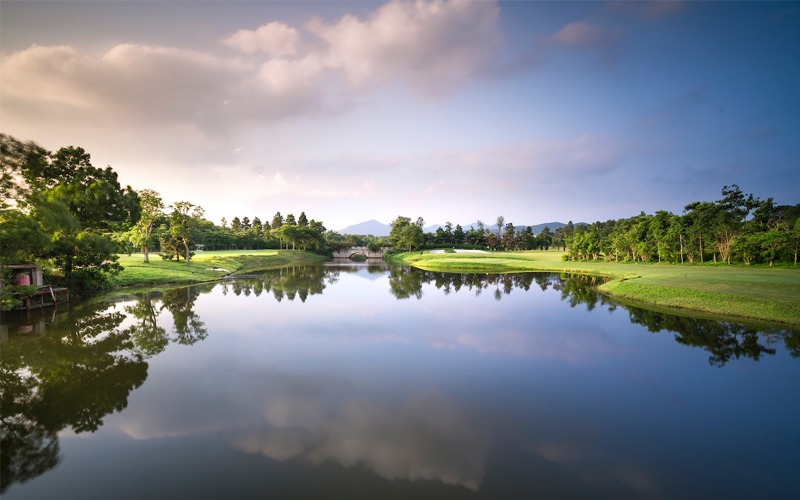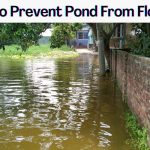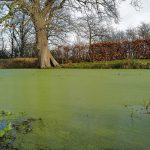Fish in ponds provide a serene and ecological balance to these aquatic ecosystems. Whether you’re a pond owner or simply curious about the origins of fish in ponds, it’s essential to understand how fish find their way into these water bodies.
This article will delve into the fascinating journey of fish into ponds, exploring the natural processes, human interventions, and ecological considerations that shape this phenomenon. So let’s see how do fish get in ponds.
24/7 Solar Air Pump For Small Pond Fish
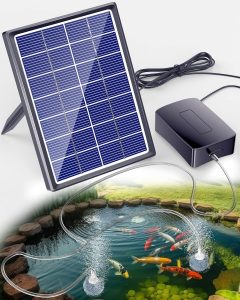
3 Surprising Facts How Do Fish Get In A Pond
There are mainly 3 common ways how do fish get in a pond, even if the pond is isolated or manmade. So let’s see the common ways fish get in a pond.
Natural Colonization:
Fish have an innate ability to colonize new environments through various natural means. This section discusses the primary ways fish naturally find their way into ponds.
1. Natural Water Sources:
Ponds often form through natural processes like rainwater accumulation, springs, or the flooding of nearby rivers or streams. In these cases, fish can enter ponds through overflow or by swimming upstream during high-water events.
2. Birds And Aquatic Plants:
Birds play a crucial role in fish dispersal. They can carry fish eggs or small fish from one body of water to another on their feathers or in their digestive systems. Additionally, aquatic plants can host fish eggs, which may be transported to ponds by waterfowl or by floating plant fragments.
3. Floods And Storms:
Extreme weather events, such as floods or heavy storms, can wash fish into ponds from nearby water bodies. These natural events often result in accidental fish introductions, contributing to the diversity of pond ecosystems.
24/7 Solar Air Pump For Small Pond Fish

Human Intervention:
Human activities play a significant role in stocking ponds with fish. This section explores the deliberate actions taken by people to introduce fish to ponds for various purposes.
1. Stocking Programs:
Pond owners and conservationists often engage in stocking programs to enhance the recreational or ecological value of ponds. This involves purchasing fish from hatcheries and releasing them into the pond.
Commonly stocked fish species include bass, bluegill, catfish, and trout, depending on the pond’s intended use.
2. Angler Releases:
Anglers sometimes release fish caught in one location into a different pond. This practice can introduce both desirable and undesirable species to a new ecosystem. It’s essential for anglers to be aware of local regulations to prevent the inadvertent spread of invasive species.
3. Aquarium Releases:
Some fish species find their way into ponds when people release unwanted aquarium fish. While well-intentioned, this practice can disrupt native ecosystems and lead to ecological imbalances. Responsible pet ownership and disposal are critical to mitigating this issue.
Ecological Considerations:
Introducing fish into ponds can have ecological implications, both positive and negative. This section delves into the ecological aspects of fish introduction and management.
1. Balancing Act:
Properly managing fish populations in ponds is essential to maintain a healthy and balanced ecosystem. Overstocking can lead to overpopulation, negatively impacting water quality and other aquatic life.
Conversely, understocking may not provide the desired recreational or ecological benefits.
2. Invasive Species:
The introduction of non-native or invasive fish species can have severe consequences. Invasive fish can outcompete native species, disrupt food chains, and alter water quality. Preventing the spread of invasive species is a crucial aspect of pond management.
3. Biodiversity And Conservation:
In some cases, ponds serve as refuges for endangered or threatened fish species. Careful management practices, such as habitat preservation and controlled stocking, can help conserve these important aquatic resources.
How Do Fish Get Into Isolated Bodies Of Water
Fish can find their way into isolated bodies of water through various natural and human-mediated mechanisms. While isolated bodies of water, such as remote ponds or lakes, are typically not connected to larger water bodies, fish still manage to populate them over time.
Here’s an overview of how fish can get into isolated bodies of water:
1. Flooding Events:
Isolated bodies of water can occasionally become connected to larger water bodies during heavy rainfall or flooding events. Fish from nearby rivers or streams may swim into these isolated water bodies when such a connection forms.
Once the water recedes, some fish may remain in the isolated water body.
2. Bird And Animal Transport:
Birds, amphibians, and even terrestrial animals can play a role in the transport of fish into isolated bodies of water. Birds, in particular, can carry fish eggs or small fish on their feathers or in their digestive systems.
When these birds visit isolated water bodies, they may unintentionally introduce fish.
3. Wind And Storms:
Strong winds and storms can result in fish being transported through the air. Small fish or fish eggs can be lifted from one water body and deposited into another, including isolated ponds or lakes.
4. Stocking Programs:
People may intentionally introduce fish into isolated bodies of water through stocking programs. These programs involve transporting fish from hatcheries or other water bodies and releasing them into the isolated water body.
The goal may be to create or enhance recreational fishing opportunities or to establish a new population of a specific fish species.
5. Angler Releases:
Anglers who catch fish in one location may release them into isolated bodies of water for various reasons, such as wanting to establish a private fishing spot or avoiding transport restrictions.
While this practice can introduce fish to isolated water bodies, it should be done responsibly to avoid negative ecological impacts.
6. Illegal Dumping:
Unfortunately, some individuals may illegally introduce fish into isolated bodies of water, often for illegal or unethical reasons. This can lead to the introduction of non-native or invasive species, which can disrupt local ecosystems.
7. Survival and Reproduction:
Once fish find their way into isolated bodies of water through any of the above means, some may survive and reproduce, establishing a self-sustaining population. Over time, these populations can grow and adapt to the conditions of the isolated water body.
It’s important to note that not all isolated bodies of water will naturally support fish populations, and the ability of fish to establish themselves in such environments can depend on a variety of factors, including water quality, habitat suitability, and the presence of predators or competitors.
Additionally, the introduction of non-native or invasive fish species into isolated water bodies can have detrimental effects on local ecosystems, emphasizing the importance of responsible and informed management practices.
How Do Fish Get Into Retention Ponds
Fish can get into retention ponds through a combination of natural processes, human activities, and ecological interactions:
Rainfall and Flooding:
Retention ponds are often designed to capture and manage stormwater runoff. During heavy rainfall or flooding events, fish can be carried into retention ponds from nearby natural water sources like rivers, streams, or drainage systems.
Bird Transport:
Birds may visit retention ponds, carrying fish eggs or small fish on their feathers or in their digestive systems. This can lead to the unintentional introduction of fish into these ponds.
Stocking Programs:
In some cases, fish may be intentionally stocked in retention ponds by landowners, property managers, or environmental agencies. These stocking programs are often aimed at improving water quality, enhancing aesthetics, or creating recreational fishing opportunities.
Angler Releases:
Anglers may release fish caught elsewhere into retention ponds for recreational purposes. However, this should be done in accordance with local regulations to prevent the introduction of unwanted species or ecological disruptions.
Survival And Reproduction:
Once fish are introduced into retention ponds through natural or human-mediated means, some of them may survive and reproduce. Over time, this can lead to the establishment of self-sustaining fish populations within the retention pond.
Can Birds Carry Fish Eggs From Pond To Pond
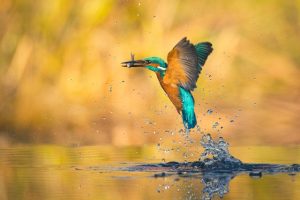
Yes, birds can indeed carry fish eggs from one pond to another. This phenomenon is known as “secondary dispersal” and plays a role in the movement of aquatic organisms, including fish, between water bodies.
Birds are the animals who help fish to get into manmade ponds. Yes, if you want to know how fish get into manmade ponds, then you should also follow this part. Here’s how it happens:
Adhesion to Feathers:
Fish eggs are often adhesive, with a sticky outer layer that allows them to adhere to various surfaces. When fish spawn in one pond, some of their eggs may attach to aquatic plants, rocks, or other objects near the spawning site.
Birds that frequent the pond can pick up these adhesive fish eggs on their feathers as they swim or forage for food in the water.
Transport By Birds:
Birds, particularly waterfowl like ducks, geese, herons, and waders, have feathers that can become coated with these sticky fish eggs. As these birds move between ponds or water bodies, they can inadvertently carry fish eggs with them.
Subsequent Deposits:
When birds land in a new pond, fish eggs attached to their feathers can be transferred into the water of the new pond. This can result in introducing fish eggs from one pond into another, aiding in the dispersal of fish species.
While this natural dispersal mechanism contributes to the movement of fish eggs between ponds, it’s important to note that the success of fish colonization through bird-mediated dispersal can vary widely.
Not all fish eggs transported by birds will survive and hatch in a new pond, as factors like water quality, predation, and environmental conditions play a crucial role in their survival and development.
Nonetheless, bird-mediated dispersal remains a fascinating example of how interconnected ecosystems can be.
Final Words
In conclusion, here we described some common ways how do fish get in ponds. In addition, the presence of fish in ponds is the result of a complex interplay between natural processes, human interventions, and ecological considerations. Understanding how fish get into ponds is essential for pond owners and conservationists alike.
Whether fish arrive through natural colonization or deliberate stocking efforts, it’s crucial to strike a balance that supports a healthy and sustainable pond ecosystem.
Responsible management practices, along with awareness of potential ecological consequences, can help ensure that fish thrive in ponds while maintaining the integrity of these aquatic environments.


